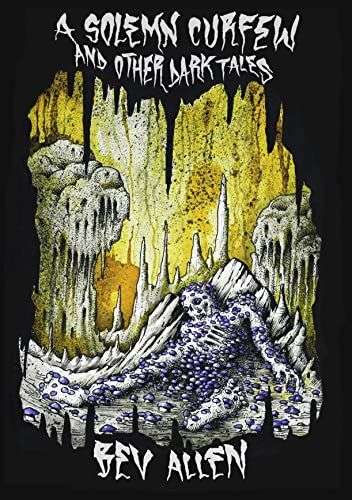A SOLEMN CURFFEW AND OTHER DARK TALES by Bev Allen from Cathaven Press #BookReview #Horror #ShortStory #Anthology
A SOLEMN CURFFEW AND OTHER DARK TALES by Bev Allen
Cathaven Press, 178 page p/b, £7.95
Reviewed by Pauline Morgan

Not all horror is the same. There is the violent, gory version in which the reader can expect bodies to be graphically dismembered at regular intervals. Then there is the idea of the menace that creeps up on the unsuspecting characters, the kind of horror that James Herbert specialised in. Again, the body count is likely to be high but with a lower volume of gore. Some writers prefer to go for the more subtle scenario wherein the reader may well feel that this could happen to them or someone they know.
 A number of the stories here deal with perceptions. In ‘Cunning Water’, Brenda has an obsession with cleanliness and tidiness. She prefers beige and doesn’t like the soothing blandness to be punctuated by other colours, especially brown. Her husband, Kevin, is a slob, and Brenda spends a frustrating time clearing up after him. It is only when he starts spending time in the garden after dark – and trailing mud through the house – that she suspects he is having an affair. Then she finds him dead and naked in the pond. The subtleness of this story is that although Brenda is oblivious to the truth of the matter, the reader is able to find the clues.
 As indicated in the title, ‘Maud: A Garden Tale’, Maud is a child whose parents give more attention to the garden than they do to her. When Maud begins to see things crawling around the garden, they dismiss it as imagination, but Maud knows these things leave death in their wake. The question left hanging at the end of the story is whether what she has seen is a portent of tragedy.
 Gardens and ponds feature in both ‘Cunning Water’ and ‘Maud: A Garden Tale’ feature gardens with ponds. In ‘The Girl In The Water’, the sea provides a greater expanse. As with Brenda in the first story, the unnamed protagonist is an obsessive. The focus of his attention is a young woman who worked at the Sea Life Centre and every day went swimming in the sea. Like many stalkers, he just thinks she is playing hard to get, but when he takes it further than just spying on her, the situation turns nasty.
 In ‘Swansong’, Gribble’s obsession is something his Granny told him – that swans sing when they die. He becomes determined to hear the swan’s death song. The story is set in fenland at an undetermined time and is probably the most gruesome story in this collection.
‘Hush-A-Bye’ is centred around an understandable obsession. Angela’s husband snores, and it has been getting worse, leaving her unable to sleep. Like most snorers, he doesn’t believe what she says. In desperation, she answers an advert which claims to guarantee success in stopping snoring. There is, she discovers, a downside to the treatment.
‘No Sure Foundation’ is the only ghost story in this volume. It works on the premise that the spirit can linger wherever a part of the body is. When Sylvia is murdered by her husband – to give himself a clear field to court his attractive neighbour – he doesn’t clean up thoroughly, and traces of blood and a lost tooth enable her to see what happens next. She is delighted when an accident gives her the opportunity to take her revenge,
The other three stories all have food as a factor. ‘Custard Creams And Elementals’ involves Marjorie, who can see elementals. These have the appearance of grotesques and cling to people. Marjorie moves into a new house after her divorce and hasn’t had time to set up her protections before a neighbour arrives with ‘welcome to your new home custard creams’ and brings a host of nasty elementals with her. This story is touched with humour.
‘Say “Cheeseâ€â€™ has a darker side. It is a historical fable. Dairywoman Gedy takes on an assistant who, on one occasion, cuts herself, and the blood goes into the milk. As Pontin wanted Gedy to account for all the milk, they turned the contaminated milk into cheese and hid the round – until Pontin discovered it and took it to the Hall. From here, the story develops its sinister tone.
The longest story in this volume is ‘A Solemn Curfew’ and revolves around food. Quine works in the kitchen of a Stately Home. He can create deliciousness from vegetables, but usually, they are relegated to garnish for more spectacular dishes. All that changes when a travelling spice seller lets him have three mushrooms. He finds the taste of these addictive. They also give him the ability to find rare metals such as gold. Quine thinks that his fortunes have changed without realising that there is a price to pay for his new gift.
 While there are elements in these latter two stories that have touches of familiarity, they are told in a refreshing way. For readers who like their horror subtle, they will find these stories well to their liking. It is also worth noting the quirky style of the cover by Mutartis Boswell, which is also a perfect illustration of the title story – though you have to read it to discover why.

